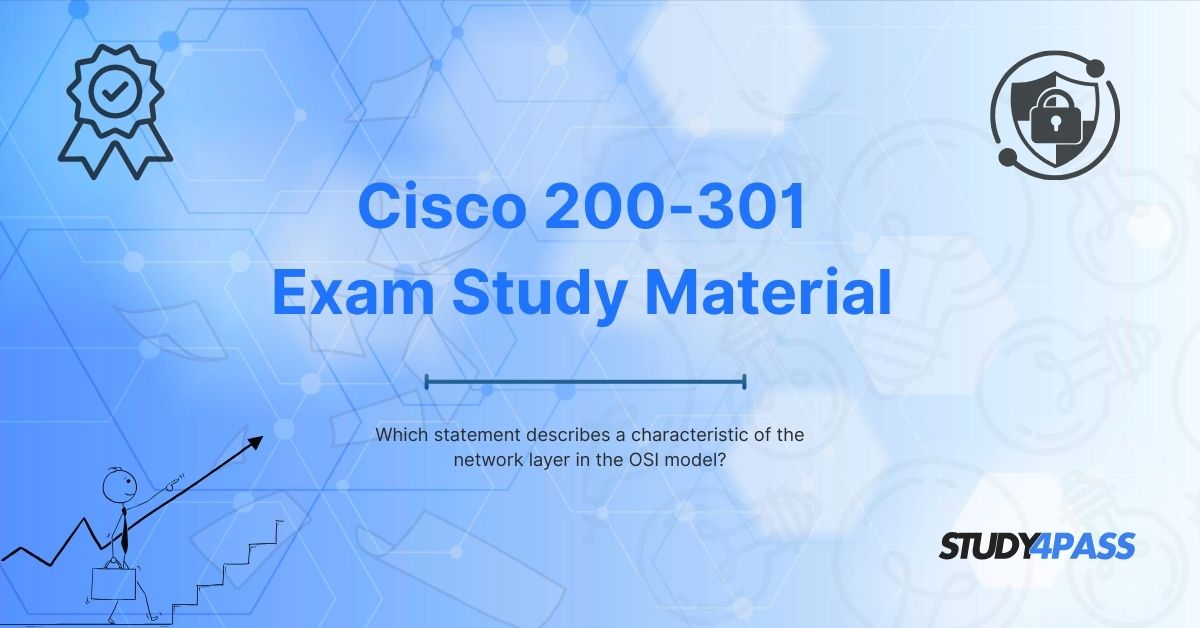Introduction
The Open Systems Interconnection (OSI) model is a fundamental framework in networking that standardizes communication functions across different systems. Among its seven layers, the network layer (Layer 3) plays a crucial role in routing and forwarding data packets across networks. For those preparing for the Cisco 200-301 CCNA exam, understanding the characteristics of the network layer is essential.
This article provides an in-depth explanation of the network layer's functionalities, its significance in the OSI model, and how it relates to real-world networking scenarios. Additionally, we will highlight how Study4Pass a leading platform for CCNA, CCDA, CCENT, CCNA Security, and CCNA Wireless exam preparation can help you master these concepts efficiently.
What is the OSI Model?
Before diving into the network layer, let’s briefly recap the OSI model:
- Physical Layer (Layer 1) – Deals with physical connections and raw bit transmission.
- Data Link Layer (Layer 2) – Handles error detection and MAC addressing.
- Network Layer (Layer 3) – Focuses on logical addressing and routing.
- Transport Layer (Layer 4) – Ensures end-to-end communication and reliability.
- Session Layer (Layer 5) – Manages connections between applications.
- Presentation Layer (Layer 6) – Translates data into a readable format.
- Application Layer (Layer 7) – Interfaces directly with user applications.
The network layer (Layer 3) is where routing and logical addressing occur, making it indispensable for internetworking.
Key Characteristics of the Network Layer
1. Logical Addressing (IP Addressing)
- The network layer assigns logical addresses (IP addresses) to devices for identification across different networks.
- Unlike MAC addresses (Layer 2), which are physical and tied to hardware, IP addresses are hierarchical and can be changed.
- IPv4 (32-bit) and IPv6 (128-bit) are the two primary versions used.
2. Routing and Path Determination
- The network layer determines the best path for data packets to travel from source to destination.
- Routers operate at this layer, using routing protocols like OSPF, EIGRP, and BGP to make decisions.
3. Packet Forwarding and Switching
- Once a path is chosen, the network layer forwards packets through intermediate routers.
- It uses forwarding tables to decide the next hop for each packet.
4. Fragmentation and Reassembly
- If a packet is too large for a network’s Maximum Transmission Unit (MTU), the network layer fragments it into smaller pieces.
- The destination device’s network layer reassembles these fragments back into the original packet.
5. Congestion Control
- The network layer helps manage network congestion by adjusting routing paths or dropping low-priority packets.
6. Inter-Networking (Connecting Different Networks)
- It enables communication between devices on different networks, such as LAN to WAN or across the internet.
Why is the Network Layer Important for the CCNA 200-301 Exam?
The Cisco 200-301 CCNA exam tests candidates on their understanding of networking fundamentals, including:
- IP addressing and subnetting
- Routing concepts (static vs. dynamic routing)
- Router configuration and troubleshooting
- Network layer protocols (IPv4, IPv6, ICMP)
A solid grasp of the network layer ensures you can:
- Configure and troubleshoot routers effectively.
- Design efficient IP addressing schemes.
- Understand how data travels across networks.
How Study4Pass Helps You Master the Network Layer for CCNA?
Preparing for the CCNA 200-301 exam requires structured learning and hands-on practice. Study4Pass offers:
1. Comprehensive Study Materials
- Detailed guides on OSI model layers, with a focus on the network layer.
- Practice questions covering IP addressing, routing protocols, and subnetting.
2. Real-World Labs and Simulations
- Hands-on router and switch simulations to reinforce theoretical knowledge.
- Step-by-step configuration exercises for OSPF, EIGRP, and static routing.
3. Expert-Led Video Tutorials
- In-depth explanations of network layer concepts by certified instructors.
- Troubleshooting scenarios to enhance problem-solving skills.
4. Practice Exams with Detailed Explanations
- CCNA mock tests that mimic the actual exam environment.
- Instant feedback and performance analytics to track progress.
5. Community Support and Discussion Forums
- Engage with fellow learners and instructors to clarify doubts.
- Access to updated exam trends and tips.
By leveraging Study4Pass, you gain a competitive edge in mastering the network layer and other critical CCNA topics.
Conclusion
The network layer (Layer 3) is the backbone of internetworking, responsible for logical addressing, routing, and packet forwarding. For CCNA 200-301 aspirants, mastering this layer is non-negotiable.
With Study4Pass, you get structured learning resources, hands-on labs, and expert guidance—making your CCNA journey smoother and more efficient. Whether you're aiming for CCNA, CCDA, CCENT, CCNA Security, or CCNA Wireless, Study4Pass equips you with the knowledge and confidence to succeed.
Start your CCNA preparation today with Study4Pass and ace your exam with flying colours!
Special Discount: Offer Valid For Limited Time “200-301 Exam Material”
Actual Exam Questions For Cisco's 200-301 Certification
Sample Questions For Cisco 200-301 Exam Prep
1. Which of the following is a primary function of the network layer in the OSI model?
A) Error detection and correction
B) Establishing and terminating connections
C) Logical addressing and routing
D) Data encryption and decryption
2. The network layer is responsible for:
A) Segmenting data into frames
B) Providing end-to-end communication between hosts
C) Translating between different data formats
D) Managing physical cabling and signaling
3. Which of the following protocols operates at the network layer?
A) TCP
B) HTTP
C) IP
D) Ethernet
4. What is the main purpose of routing at the network layer?
A) To convert domain names to IP addresses
B) To determine the best path for data packets to travel
C) To encrypt data for secure transmission
D) To synchronize communication between devices
5. Which of the following devices primarily operates at the network layer?
A) Hub
B) Switch
C) Router
D) Repeater


